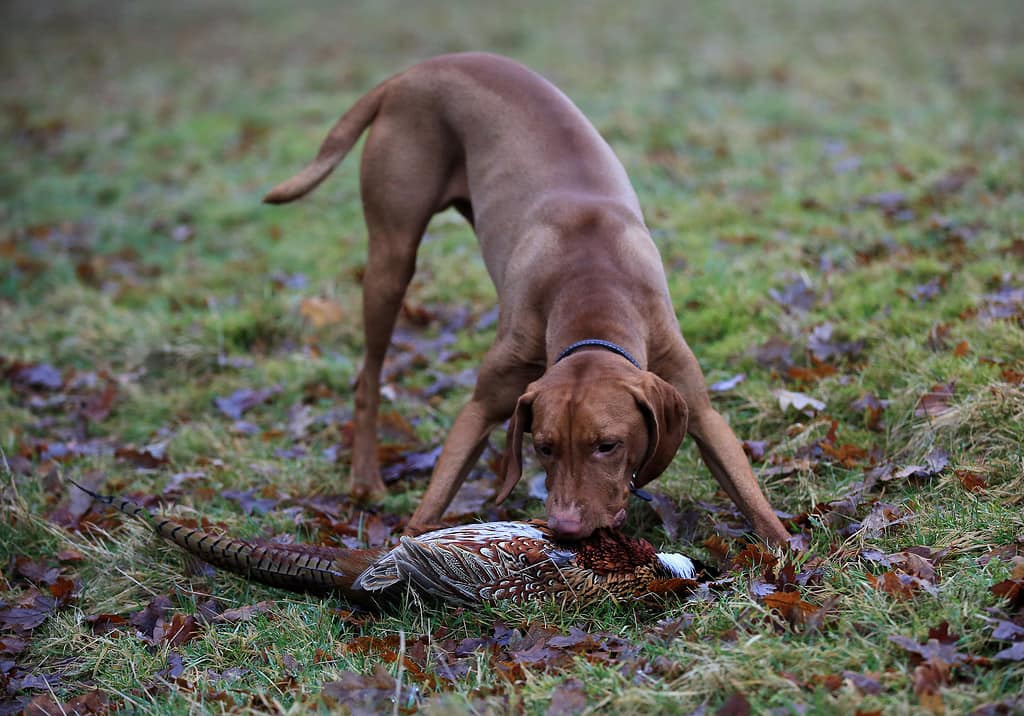Vizslas and Labrador Retrievers may have been bred for similar purposes. However, they are exceptionally different as companion dogs. Vizslas tend to be more independent and strong-willed, so they aren’t the best choice for first-time owners. On the other hand. Labrador Retrievers tend to be easier to train and friendlier.
The differences don’t end here, though. These canines have several other temperament and care differences that you should keep in mind before deciding which one to adopt:
1. Vizsla vs. Labrador Retriever: Temperament

Because they were bred as pointing dogs, Vizslas can be independent thinkers, making training a bit of a challenge.
©The_Chickenwing/iStock via Getty Images
Vizslas are known for being pretty friendly and sociable, especially when well-trained. However, they also tend to be very hyperactive dogs, particularly when not exercised enough. Some may get a bit too excited in new situations or when meeting new people.
Others are easily startled, especially by loud noises like thunder. Vizslas often seem confident and sociable, but they can develop major phobias without proper socialization.
Labrador Retrievers are often billed as the perfect family dog. They’re good-natured and tend to get along with everyone. However, they’re also very active. Not giving them enough exercise can quickly lead to rambunctiousness. In this way, they’re similar to the Vizsla.
That said, these two breeds differ a lot when it comes to their willingness to obey commands.
Vizslas are very independent, starkly contrasting with Labrador Retrievers. As a pointing breed, Vizslas tend to be a bit harder to train, especially for new dog owners. Labrador Retrievers can be much more willing to listen to commands and are easier to train. However, some Labs can have stubborn streaks, especially around puberty.
Vizslas also tend to be more “velcro” dogs. In other words, they act like they need constant physical contact. They’ll also be very mouthy. Labrador Retrievers bond closely with their owners but don’t tend to be quite as physical.
2. Vizsla vs. Labrador Retriever: Activity Level

No matter what breed you decide to adopt, it’s important to start training and socialization very
early.
©Caroline Anderson/iStock via Getty Images
Vizslas and Labrador Retrievers are both very active dogs. Vizslas were made to spend much of the day in the field, hunting, as were Labs. However, Vizslas are still bred as mostly hunting dogs, which means their high level of endurance is prized by many breeders.
On the other hand, Labs are one of the most popular companion dogs in the United States. Therefore, many breeders are breeding them as companion animals. Their friendliness is often prioritized over their working ability in some lines. Therefore, if you purchase a companion-bred Lab, they may need less exercise than a Vizsla.
Still, working Labs have very high exercise needs, just like a Vizsla, so it largely depends on the goals of your breeder.
3. Vizsla vs. Labrador Retriever: Trainability

While they are more challenging to train, Vizslas absolutely can
be trained, so don’t lose hope if you decide to adopt one of these dogs.
©vauvau/iStock / Getty Images Plus via Getty Images
Labrador Retrievers are far more trainable than a Vizsla for your average dog owner. A Lab is often easier to train if you aren’t a dog-training expert. They tend to be more eager to please and are more likely to listen to commands in real-world situations. This breed is often seen in agility and obedience competitions for this reason.
That said, Vizslas are pretty intelligent dogs who can pick up on commands relatively easily. The biggest difference is that a Vizsla tends to be more independent. They may not follow commands in real-world situations, even if they know what the cue means.
Vizslas also tend to be more distractable. They may have selective hearing when an interesting sight or smell comes around. They typically do better with an experienced dog owner for this reason.
Labradors do tend to mature slower than Vizslas, though. Therefore, Labs may go through their “teen” stubborn stage for longer. They aren’t always a breeze to train, and it’s important not to wear rose-colored glasses when purchasing a puppy.
4. Vizsla vs. Labrador Retriever: Grooming

Labrador Retrievers have fairly thick coats, so they typically require more grooming than a Vizsla.
©4 PM production/Shutterstock.com
These dogs have very different grooming requirements. Vizslas do not need much grooming at all. They have a very smooth, short coat that does a good job of keeping itself clean. They do shed somewhat, but their hairs are very small. Many owners still brush them once a week or so to control the shedding.
On the other hand, Labs have a thick, double-coat that requires regular brushing. They can develop tangles and mats if not brushed properly, for instance. They also shed a lot more, and their longer, denser fur can make more of a mess. You may even notice significant seasonal shedding around the fall and spring months.
Owners will often spend more time grooming their Lab than their Vizsla. Keep this in mind when deciding between the breeds.
Which Dog Breed is Best for You?
Vizslas and Labrador Retrievers have many things in common, but you should consider some of these noteworthy differences when choosing between these breeds.
We primarily recommend Vizslas for active, experienced dog owners. If you’re planning on hunting with these dogs, even better. They don’t require much grooming, but you will be committing a lot of time to exercise.
On the other hand, Labrador Retrievers make better dogs for first-time dog owners with children. There is a reason they’re one of the most popular family dogs in the United States. However, ensure you have enough time to commit to their grooming and exercise needs, which can be substantial.
Thank you for reading! Have some feedback for us? Contact the AZ Animals editorial team.








